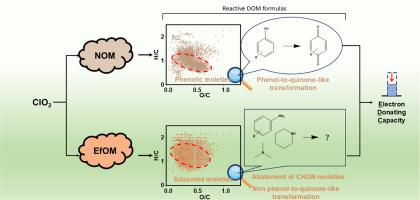Molecular composition difference of electron donating moieties between natural organic matter and effluent organic matter probed by chlorine dioxide
IF 11.4
1区 环境科学与生态学
Q1 ENGINEERING, ENVIRONMENTAL
引用次数: 0
Abstract
Lignin- and tannin-like phenolic compounds are shown to be the major compositions of electron donating moieties (EDM) of aquatic natural organic matter (NOM). However, little is known about the compositions of EDMs within effluent organic matter (EfOM). In the present study, chlorine dioxide (ClO2) was used as a selectively oxidative probe to investigate the difference in the molecular composition of EDM between NOM and EfOM due to its high selectivity towards electron-rich compounds. The results showed that there was a large difference in the bulk and molecular properties of ClO2-reactive moieties between EfOM and NOM. Specifically, ClO2-reactive moieties of EfOM are distributed in a narrower molecular weight range (i.e., 0.9 kDa to 3.0 kDa) compared to NOM (i.e., 1.0 kDa to 20 kDa). The molecular-level analysis demonstrated that highly aromatic, reduced formulas (O/C = 0.33 ± 0.16; H/C = 1.10 ± 0.34) referring the lignin- and tannin-like compounds within both NOM and EfOM were susceptible to oxidation by ClO2, while more saturated formulas including the peptide-like formulas (H/C = 1.59 ± 0.36) within EfOM were reactive towards ClO2. Furthermore, the nitrogen (N)-containing formulas in EfOM are suggested to be the major EDMs compared to the CHO-only formulas dominating the EDM in NOM. This study has important implications for understanding of the origin and chemical nature of EDM in DOM from various sources and provides molecular-level evidence for the selectivity of ClO2 as an oxidant towards DOM.


二氧化氯探测天然有机物与流出有机物供电子部分的分子组成差异
木质素类和单宁类酚类化合物是水生天然有机物(NOM)中给电子基团(EDM)的主要组成。然而,人们对废水有机物(EfOM)中edm的组成知之甚少。在本研究中,二氧化氯(ClO2)作为选择性氧化探针,研究了由于其对富电子化合物的高选择性,NOM和EfOM之间EDM分子组成的差异。结果表明,EfOM和NOM的clo2活性部分的体积和分子性质存在较大差异,其中EfOM的clo2活性部分分布在较窄的分子量范围内(即0.9 kDa至3.0 kDa),而NOM的clo2活性部分分布在1.0 kDa至20 kDa之间。分子水平分析表明,高芳香族,还原式(O/C = 0.33±0.16;H/C = 1.10±0.34),说明NOM和EfOM中木素类和单宁类化合物容易被ClO2氧化,而EfOM中更饱和的化合物,包括肽类化合物(H/C = 1.59±0.36)对ClO2有反应。此外,与仅含cho的分子式相比,EfOM中的含氮分子式是主要的EDM。该研究对了解DOM中各种来源的EDM的起源和化学性质具有重要意义,并为ClO2作为氧化剂对DOM的选择性提供了分子水平的证据。
本文章由计算机程序翻译,如有差异,请以英文原文为准。
求助全文
约1分钟内获得全文
求助全文
来源期刊

Water Research
环境科学-工程:环境
CiteScore
20.80
自引率
9.40%
发文量
1307
审稿时长
38 days
期刊介绍:
Water Research, along with its open access companion journal Water Research X, serves as a platform for publishing original research papers covering various aspects of the science and technology related to the anthropogenic water cycle, water quality, and its management worldwide. The audience targeted by the journal comprises biologists, chemical engineers, chemists, civil engineers, environmental engineers, limnologists, and microbiologists. The scope of the journal include:
•Treatment processes for water and wastewaters (municipal, agricultural, industrial, and on-site treatment), including resource recovery and residuals management;
•Urban hydrology including sewer systems, stormwater management, and green infrastructure;
•Drinking water treatment and distribution;
•Potable and non-potable water reuse;
•Sanitation, public health, and risk assessment;
•Anaerobic digestion, solid and hazardous waste management, including source characterization and the effects and control of leachates and gaseous emissions;
•Contaminants (chemical, microbial, anthropogenic particles such as nanoparticles or microplastics) and related water quality sensing, monitoring, fate, and assessment;
•Anthropogenic impacts on inland, tidal, coastal and urban waters, focusing on surface and ground waters, and point and non-point sources of pollution;
•Environmental restoration, linked to surface water, groundwater and groundwater remediation;
•Analysis of the interfaces between sediments and water, and between water and atmosphere, focusing specifically on anthropogenic impacts;
•Mathematical modelling, systems analysis, machine learning, and beneficial use of big data related to the anthropogenic water cycle;
•Socio-economic, policy, and regulations studies.
 求助内容:
求助内容: 应助结果提醒方式:
应助结果提醒方式:


